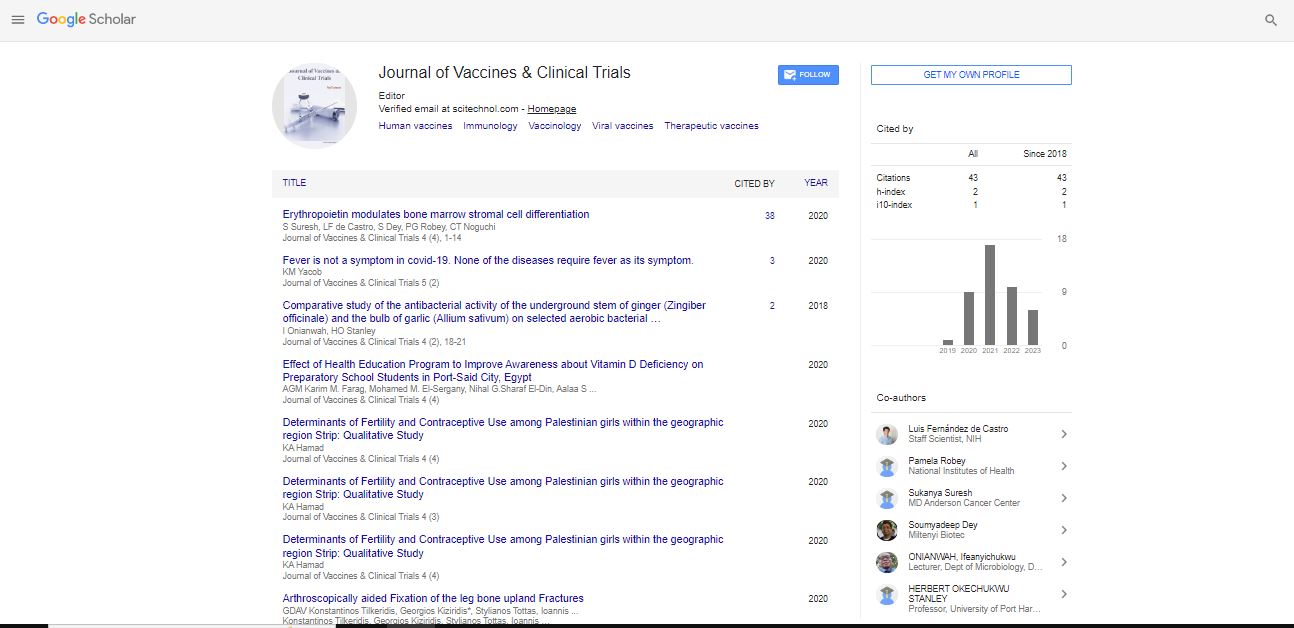Perspective, Jou Of Vac Cli Tr Vol: 7 Issue: 4
Impact of Rabies: Its Transmission and Prevention
Zhong Lin*
1Department of Bacteriology, China University of Geosciences, Wuhan, PR China
*Corresponding Author: Zhong Lin,
Department of Bacteriology, China University
of Geosciences, Wuhan, PR China
E-mail: Lin_zhong@edu.cn
Received date: 27 November, 2023, Manuscript No. JVCT-24-128363;
Editor assigned date: 30 November, 2023, PreQC No. JVCT-24-128363 (PQ);
Reviewed date: 07 December, 2023, QC No. JVCT-24-128363;
Revised date: 21 December, 2023, Manuscript No. JVCT-24-128363 (R);
Published date: 28 December, 2023 DOI: 10.4172/JVCT.100093
Citation: Lin Z (2023) Impact of Rabies: Its Transmission and Prevention. Jou of Vac Cli Tr 7:4.
Description
Rabies, a viral disease, holds a place as one of the most dreaded and misunderstood illnesses known to humankind. The mere mention of its name evokes fear due to its almost certain fatality once symptoms manifest. While advancements in medicine have made it preventable, it remains a significant public health concern, particularly in regions where vaccination programs are not widespread.
Rabies stems from the Lyssa virus genus, primarily transmitted through the saliva of infected animals to humans, commonly through bites or scratches. The virus targets the central nervous system, causing acute inflammation in the brain. Its incubation period, ranging from days to years, often creates challenges in early detection and treatment.
The disease progresses in distinct stages. Initially, individuals may experience non-specific symptoms such as fever, headache, and discomfort at the site of exposure. As the virus spreads, neurological symptoms emerge, including anxiety, confusion, agitation, hallucinations, and paralysis. The infamous hydrophobia, where the fear of water becomes pronounced due to painful spasms while swallowing, is a classical sign.
Most cases of rabies transmission occur through wild animals like bats, raccoons, foxes, and skunks. Domesticated animals like dogs remain the primary carriers in regions with insufficient vaccination programs. Vaccination post-exposure and pre-exposure remains the most effective preventive measure, along with prompt wound care and administration of immunoglobulin and vaccines after exposure.
While developed nations have successfully controlled rabies through extensive vaccination of domestic animals and access to post exposure treatments, in developing countries, it still poses a considerable threat due to limited resources and infrastructure. Lack of awareness, inaccessible healthcare, and insufficient surveillance systems contribute to higher rates of rabies-related deaths in these regions.
Combatting rabies involves multifaceted challenges. Education about responsible pet ownership, widespread vaccination campaigns for animals and improved access to post-exposure prophylaxis for humans are critical. Strengthening veterinary and healthcare infrastructure in at-risk areas, along with collaboration between governments, NGOs, and international organizations, is essential to achieve global eradication goals.
Wildlife reservoirs contribute significantly to rabies transmission. Efforts to control rabies in wildlife involve vaccination programs for wild animals, targeted surveillance, and understanding the ecological dynamics of the disease. Such initiatives aim to reduce the transmission risk from wildlife to domesticated animals and humans.
Advancements in molecular biology, virology, and vaccine development continue to enhance our understanding of the virus and its transmission. Novel techniques, including oral vaccines for wildlife and new-generation human vaccines, hold promise in controlling and preventing the spread of rabies more effectively.
The fear associated with rabies often leads to stigmatization of affected individuals and their families. This stigma can hinder timely medical intervention and support. Addressing societal misconceptions and fostering empathy towards those affected are crucial in mitigating the social impact of the disease.
Eradicating rabies globally requires coordinated efforts on a massive scale. International collaboration, resource allocation, and knowledge sharing among countries and organizations are pivotal. Programs that integrate community engagement, education, and sustainable healthcare interventions are vital steps towards achieving a rabies-free world.
Rabies, despite being a centuries-old disease, continues to pose a threat to human and animal health worldwide. While progress has been made in controlling the disease in many regions, challenges persist, especially in areas with limited resources. Addressing these challenges demands a concerted effort from governments, healthcare providers, researchers, and communities to ensure accessible prevention measures, effective treatments, and widespread awareness. Through collective action and innovation, the goal of eliminating rabies and protecting future generations from its lethal grip remains within reach.
 Spanish
Spanish  Chinese
Chinese  Russian
Russian  German
German  French
French  Japanese
Japanese  Portuguese
Portuguese  Hindi
Hindi 